Plant-based dyes offer stunning natural colors for your cold process soap while adding skin-loving benefits. You'll find rich reds from madder root, golden yellows from turmeric, and vibrant oranges from annatto seeds. Alkanet root delivers purple hues, while green clay and spirulina create earthy greens. Indigo powder produces deep blues, and activated charcoal achieves perfect black tones. Rose kaolin clay rounds out your natural palette with delicate pinks. Discover how these seven botanical colorants can transform your next soap-making project.
Exploring Madder Root's Rich Red Spectrum
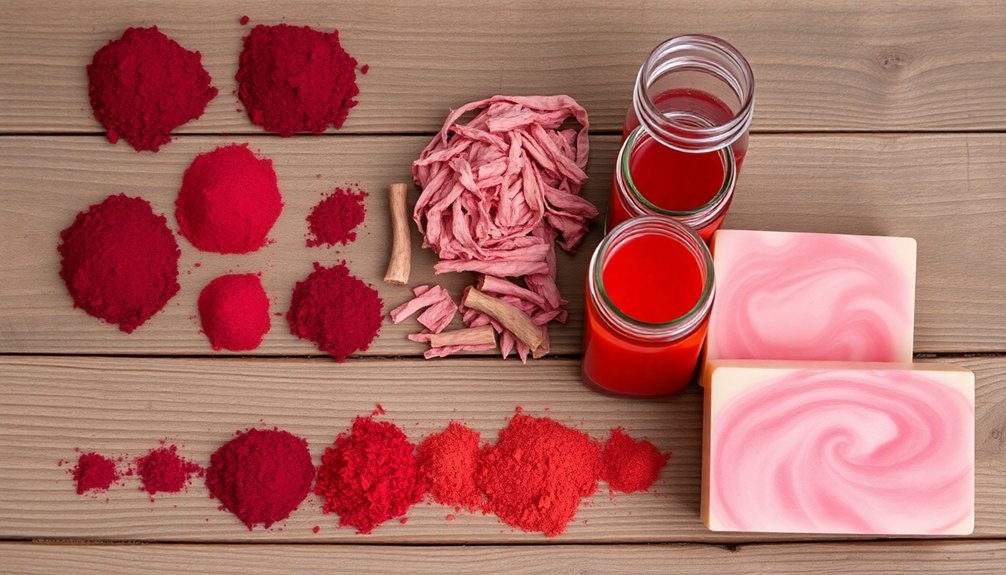
Nature's crimson miracle, madder root extract, offers soap makers an impressive range of red hues from delicate pink to deep scarlet.
From nature's vibrant palette comes madder root, a remarkable botanical extract yielding rich reds and delicate pinks for the artisan soapmaker.
You'll find this natural dye particularly effective in cold process soap, where just 3 grams per pound of soap will help you achieve your desired shade.
What's fascinating is how the color evolves during the curing process.
Don't be alarmed when your soap batter initially appears purple-brown – that's completely normal.
As your soap cures, you'll witness a remarkable transformation to vibrant red tones.
One of madder root's greatest strengths is its staying power; your soap's color won't fade or bleed over time.
Turmeric and Annatto: Golden to Orange Hues
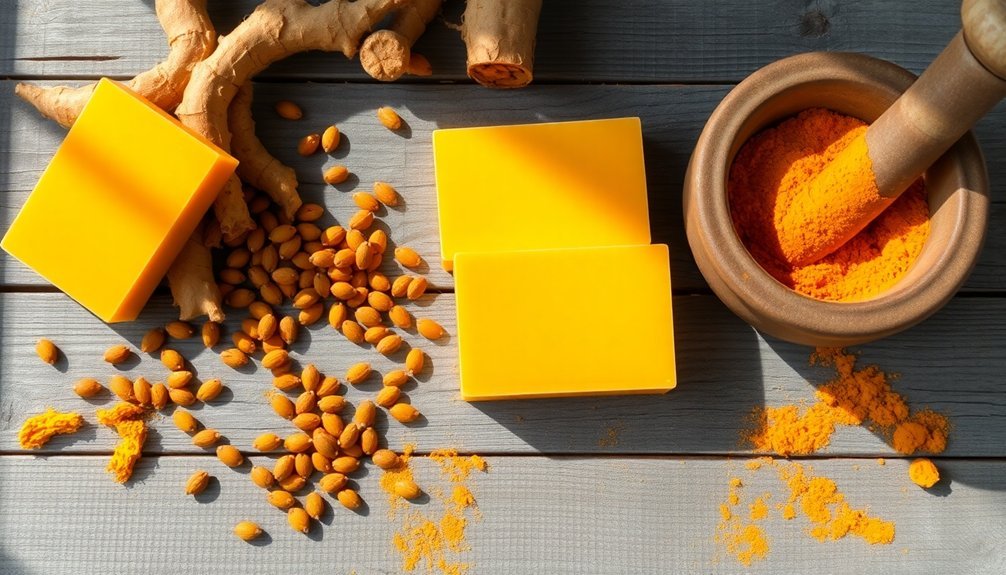
While many soapmakers seek natural alternatives to synthetic dyes, turmeric and annatto stand out as two powerful plant-based options for achieving warm golden and orange tones.
You'll find turmeric powder particularly effective as a natural colorant, creating beautiful yellow to golden hues while offering antibacterial benefits. Just remember to limit its usage to 5% of your total soap weight for ideal results.
For vibrant orange tones, you can't go wrong with annatto seeds. You'll get the best results by infusing these seeds in your soaping oils before beginning the process. This method guarantees even color distribution throughout your final product.
Both these plant-based options support sustainable soap making practices, allowing you to create stunning colors without relying on artificial dyes.
Alkanet Root's Purple Possibilities
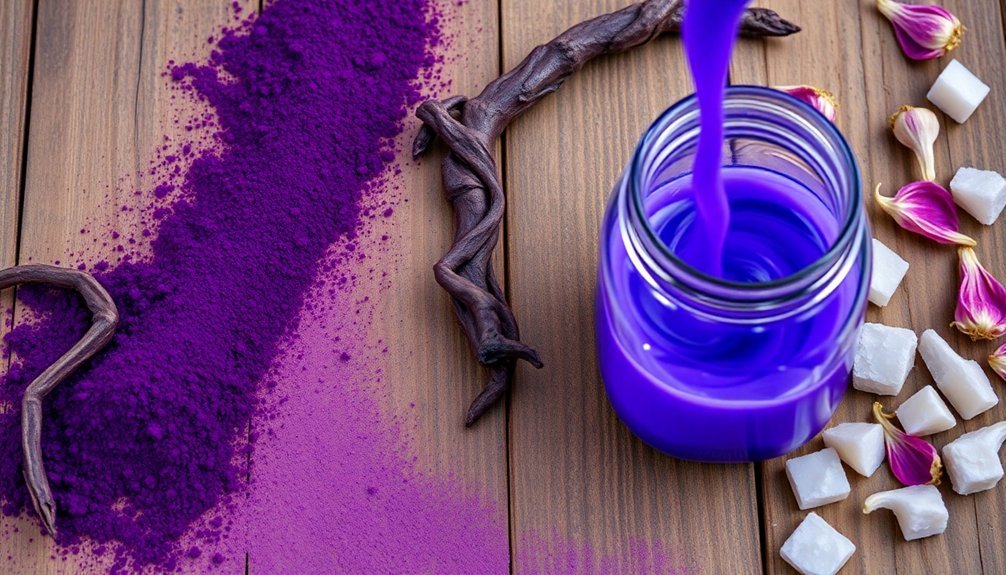
For soapmakers seeking natural purple hues, alkanet root offers an impressive spectrum of possibilities from delicate lavender to deep violet tones.
To harness this versatile natural soap colorant effectively, you'll need to infuse the dried root in your carrier oil before adding it to your cold process soap mixture.
Infuse dried alkanet root in carrier oil first to unlock its full potential as a natural purple soap colorant.
When working with alkanet root, remember that pH levels play an essential role in determining your final color – higher pH values typically yield more vibrant purples.
You'll want to limit your usage to 5% of your total soap weight for best results without compromising your formula.
While this natural dye creates stunning purple shades, be aware that the colors may gradually fade with time and light exposure.
Store your alkanet-colored soaps properly to maintain their beautiful purple hues longer.
Green Clay and Spirulina Combinations
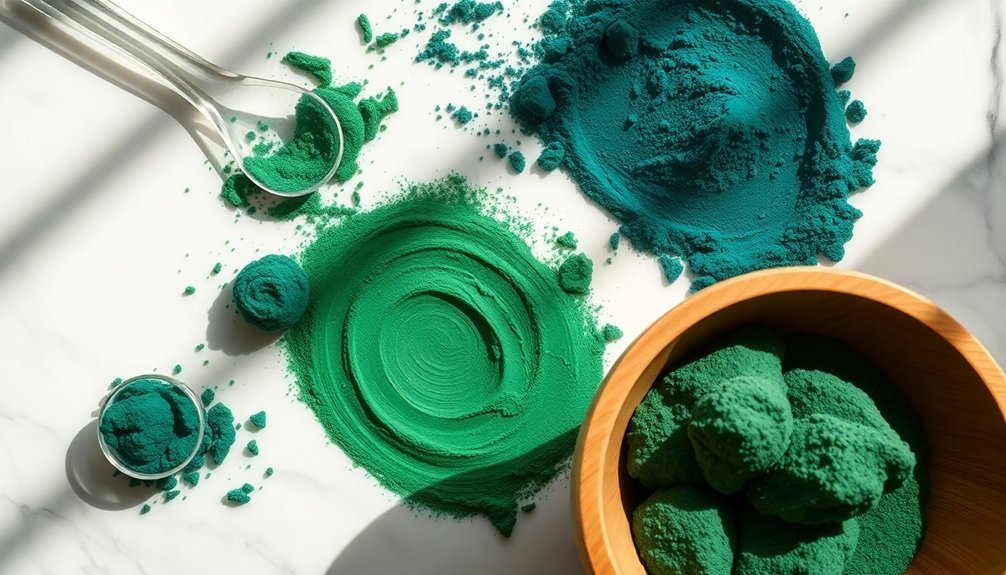
Combining green clay with spirulina powder creates an extraordinary palette of green hues perfect for natural soapmaking.
You'll find these earth-derived colorants offer both aesthetic appeal and skin-nurturing benefits. When you blend green clay's muted tones with spirulina's natural blue-green pigments, you'll achieve unique, earthy shades while harnessing their detoxifying properties.
For best results with these natural colorants:
- Start with small test batches to determine how the colors develop during the curing process.
- Keep total colorant amounts under 5% of your soap's weight to maintain proper texture.
- Mix your green clay and spirulina powder in different ratios to discover your preferred shade.
Remember to document your successful combinations, as these natural colorants may behave differently than synthetic alternatives in cold process soap making.
Indigo's Deep Blue Variations
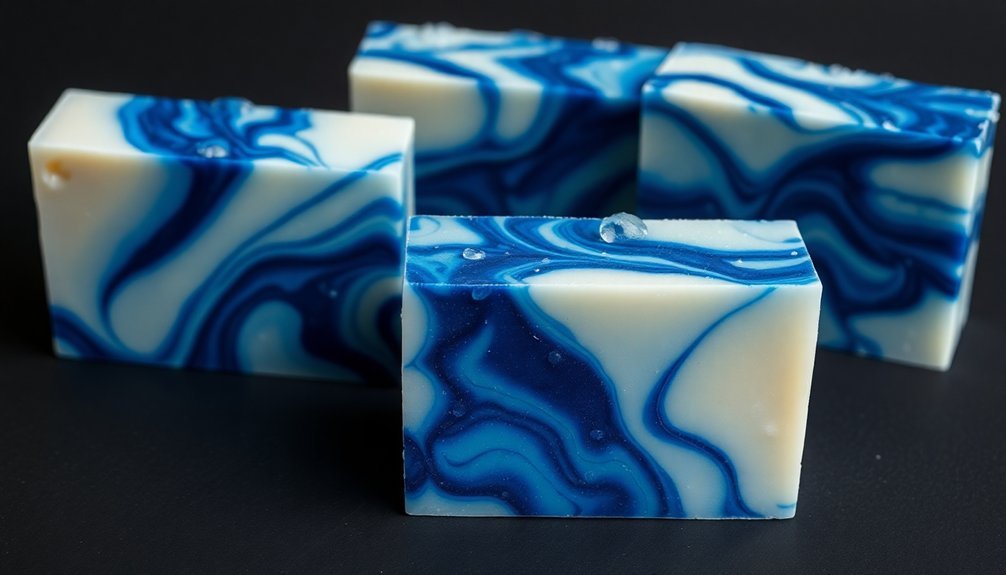
As soapmakers explore natural colorants, indigo powder stands out for its ability to create stunning blue variations ranging from soft denim to midnight navy.
You'll need to add 1-3 teaspoons per pound of oils, adjusting the amount to achieve your desired blue shade in cold process soap.
When you're working with indigo powder, don't be alarmed by its initial greenish appearance – it'll transform into a rich blue during the curing process as the pH stabilizes.
To prevent clumping and guarantee even distribution, you'll want to mix the powder into your lye solution or oils before adding it to your soap batter.
For smooth, evenly colored soap, pre-mix indigo powder with your lye solution or oils rather than adding it directly to the batter.
What makes indigo particularly valuable is its excellent lightfastness, so your beautiful blue shades won't fade over time, keeping your soap looking vibrant throughout its shelf life.
Natural Black With Activated Charcoal
Many soapmakers turn to activated charcoal for creating deep black soaps that double as skin-purifying treatments. This natural colorant is especially effective in cold process soap, transforming from an initial gray tone to a rich, deep black during the curing process.
You'll find it's an affordable option at just $3.59, making it accessible for both beginners and experienced crafters.
When working with activated charcoal in your soap making, follow these essential guidelines:
- Use no more than 1 tablespoon per pound of soap for ideal distribution
- Expect an initial ashy appearance that will deepen over time
- Consider your skin type – it's suitable for all, but particularly beneficial for oily or acne-prone complexions
The powder's detoxifying properties make it a practical choice for creating therapeutic soaps that both cleanse and purify.
Achieving Pink With Rose Kaolin Clay
Moving from the deep tones of charcoal, Rose Kaolin Clay offers soapmakers a natural way to create soft, rosy hues in their products.
When you're looking to color your soap naturally, this versatile clay provides a reliable option that's gentle on all skin types.
You'll find that Rose Kaolin Clay blends seamlessly into your soap batter, creating a creamy texture while maintaining its delicate pink shade throughout the curing process.
To achieve the best results, incorporate the clay at up to 5% of your total soap weight.
Add Rose Kaolin Clay at 5% or less of total soap weight for optimal color and texture in your handmade soaps.
What makes this natural colorant especially appealing is that it won't strip away your skin's essential oils, ensuring your finished soap remains moisturizing.
The clay's stable pigmentation means you'll get consistent, beautiful results that retain their rosy charm long after your soap has cured.
Frequently Asked Questions
What Are the Natural Dyes From Plants for Soap?
You'll find natural soap dyes in madder root for reds, turmeric for yellows, spirulina for blue-greens, and various flowers and clays. They're rich in antioxidants and shouldn't exceed 5% of total weight.
What Are the Best Natural Pigments for Soap?
You'll get the best results using French Green Clay for earthy tones, madder root for reds, turmeric for yellows, and spirulina for blue-green shades. These natural pigments offer reliable coloring with minimal fading.
What Is the Natural Purple Color for Soap Making?
You'll get the best natural purple color in your soap using alkanet root or gromwell root. They'll transform from reddish-brown to vibrant purple during curing. Use 1-2 teaspoons per pound for ideal results.
What Herbs Are Good for Coloring Soap?
You'll get vibrant colors using madder root for pink-red, alkanet root for purple, turmeric for yellow, spirulina for blue-green, and annatto seeds for orange. These herbs create natural, skin-friendly soap colorants.
In Summary
You've now got seven stunning natural dye options to create vibrant cold process soaps. Whether you're aiming for rich reds with madder root or deep blues with indigo, these plant-based colors will transform your soaps into works of art. Don't be afraid to experiment with different concentrations and combinations. Your homemade soaps will stand out with these natural alternatives to synthetic dyes.





Leave a Reply